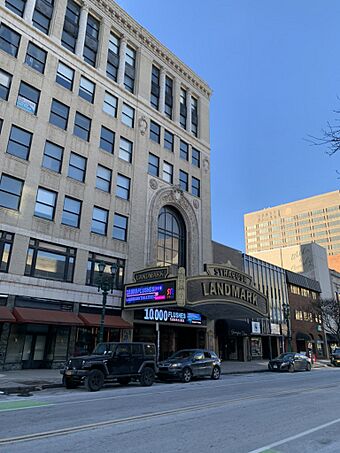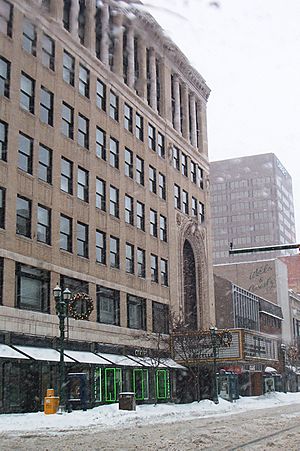Landmark Theatre (Syracuse, New York) facts for kids
|
Loew's State Theater
|
|

The Theatre's exterior in January 2023
|
|
| Address | 362 S. Salina Street Syracuse, New York United States |
|---|---|
| Owner | Syracuse Area Landmark Theatre |
| Type | Movie palace |
| Capacity | 2,908 |
| Screens | 1 |
| Current use | Performing arts center |
| Opened | February 18, 1928 |
| Website | |
|
Loew's State Theater
|
|
| Location | 362-374 S. Salina St., Syracuse, NY |
| Architect | Thomas W. Lamb |
| Architectural style | Classical Revival |
| NRHP reference No. | 77000970 |
| Added to NRHP | May 02, 1977 |
The Landmark Theatre is a historic theater in Syracuse, New York. When it first opened, it was called Loew's State Theater. It is a special type of theater known as a movie palace. These were large, fancy theaters built in the 1920s that made going to the movies feel like a grand event.
Designed by the famous architect Thomas W. Lamb, the Landmark is the last movie palace from that time still standing in Syracuse. Because of its historical importance, it is listed on the National Register of Historic Places. This means it is officially recognized as a place worth protecting.
Contents
A Theater's Grand History
Opening Night and Golden Years
The Loew's Corporation, a company that owned many theaters, announced plans for this new theater in 1926. It opened two years later, on February 18, 1928. Audiences were treated to both first-run movies and live vaudeville shows. Vaudeville was a type of entertainment with a mix of acts, like singers, comedians, and dancers.
Even during difficult times like the Great Depression and World War II, the theater was very popular. It offered people a chance to escape their worries for a few hours in a beautiful setting.
A Narrow Escape from Demolition
By the 1970s, fewer people were coming to the theater. It fell into disrepair and had to close in 1975. There were even plans to tear it down.
Luckily, a group of concerned citizens formed an organization in 1976 called the Syracuse Area Landmark Theatre, or SALT. Their goal was to save and restore the historic building. In 1977, the musician Harry Chapin held a benefit concert that helped raise $65,000. This money allowed SALT to buy the theater. After they bought it, they renamed it the Landmark Theatre.
Bringing the Landmark into the 21st Century
From 2010 to 2011, the theater underwent a $16 million renovation. This project expanded the backstage area and added new dressing rooms. These changes made it possible for the theater to host bigger and longer-running shows.
The renovation also moved the box office and updated the outside of the building. The upper floors of the building, which have a separate entrance, were turned into 24 condominium apartments.
On September 12, 2008, the Landmark Theatre hosted the world premiere of the movie The Express. The movie is about Ernie Davis, a famous football player from Syracuse University. The movie's stars, Rob Brown and Dennis Quaid, attended the event.
The Theater's Unique Design
The architect, Thomas Lamb, described the theater's style as a mix of European, Byzantine, and Romanesque designs. He said it was like "the Orient as it came to us through the merchants of Venice." This created a very exotic and luxurious feel.
The lobby once had a huge chandelier that was originally designed by Louis Tiffany for the mansion of Cornelius Vanderbilt, a wealthy businessman. The theater also had a large Wurlitzer organ with 1,400 pipes. Sadly, both the chandelier and the organ were sold in the 1970s before the theater was saved.
Another amazing feature was a fishpond with a Japanese pagoda fountain in the promenade lobby. While the pond is gone, the theater's rich red and gold colors and large murals have been carefully restored. Today, the beautiful lobby is used for special events.



